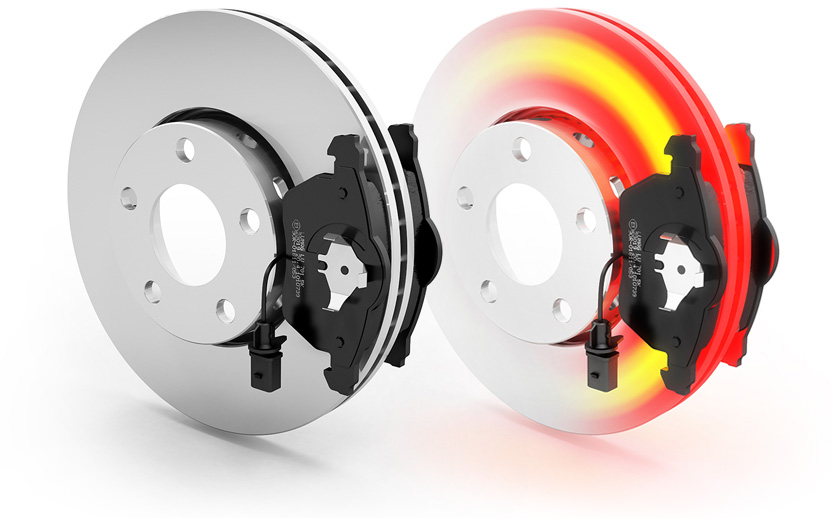 Friction material suppliers Lumag, the OE specialists behind pioneering BRECK brand, lends Garage Wire readers its technical expertise in diagnosing issues with brake discs and their likely causes.
Friction material suppliers Lumag, the OE specialists behind pioneering BRECK brand, lends Garage Wire readers its technical expertise in diagnosing issues with brake discs and their likely causes.
Issue: Cracked disc
Cause: Thermal shock loads on the surface of the brake disc. These cracks reduce the disc’s strength and can, depending on size and applied forces, result in material fracture. Cracking that is clearly visible to the naked eye should be replaced.
Issue: Stick-slip
Cause: When static friction exceeds kinetic friction. As a result, the pad and disc surfaces disconnect and start to ‘slip’. This lasts until both surfaces ‘stick’ back together.
Issue: Scored marks on the friction ring surface
Cause: This can be as a result of various scenarios including corrosion; unsuitable brake pad friction material; severe soiling of the brake discs or pads; overloading of the brake system; unsuitably soft brake disc material.
Issue: Squeaks of various frequencies
Cause: Low-frequency squeaks (1kHz – ~3kHz) are generated by, for example, rods, calipers and yokes, as a result of play between various linkage components. On the other hand, medium and high-frequency squeaks (4kHz – ~16kHz) are generated by discs and pads. The causes of vibration coming from the disc are deviations in thickness (DTV), hot spots and improper cast iron.
Issue: Groan and moan
Cause: The vehicle starts moving when the speed of up to 2 rpm is reached and when the pressure in the system is low. It is a series of fluctuations caused by sticking and slipping of the pad and the disc. Possible causes of groaning include deformation of discs and pads, transfer of the friction material to the disc surface and variation of the friction coefficient.
Issue: Judder
Cause: Changes in the braking torque which occur during braking or, more accurately, in the
course of a full brake disc revolution. Brake judder is the main cause of brake disc related issues and is subdivided as follows:
- Thermal judder – which occurs during deceleration from high speeds and when the disc temperature is higher than 200°C
- Cold judder – which can occur at any speed and when the disc temperature is less than 100°C
- High velocity judder – when speeds reach over 80 mph
- ‘Green’ judder – with newly installed discs and pads during braking-in, which shows a good initial braking performance
Find out more
For further details on LUMAG’s ranges available to the aftermarket, including its own BRECK brand, please call 0121 520 1160 or email office@lumagltd.co.uk. Alternatively, visit www.lumagltd.co.uk to find the latest products.
For more information, interviews or images please contact:
Claire Brown or Kimberley Hornby, Hornby Whitefoot PR
Tel: 07787 505963 E-mail:claire@hornbywhitefootpr.co.uk
Tel: 07851 610573 E-mail: kimberley@hornbywhitefootpr.co.uk
About LUMAG
With a history spanning almost 30 years, LUMAG was founded in Poland in 1988 by CEO Marek Żak, initially focusing on the production of brake linings before later implementing its own brake pad manufacturing technology. Over the years the company has achieved enormous technological progress, through applied engineering solutions as well as the continuous rise of quality and safety standards.
Since September 2013 it has been operating out of a purpose built new production facility located 60km from Poznań in the town of Budzyń, covering an area of approx. 19,000 square metres, allowing the company to satisfy ever-growing customer needs and to meet strict demands of the OEM market.
The factory features an automated mixing facility, designed and custom-built for the manufacture of friction materials, coupled with high-capacity processing lines. The investment has multiplied its previous production capacity and allowed it to increase its headcount by around 10%.
The company’s mission is to supply car and commercial vehicle users with high-quality products ensuring safe braking, and in doing so, improving the safety of all road users.
LUMAG’s UK operations are based in Doncaster, South Yorkshire.
Further information can be found at www.lumagltd.co.uk.
